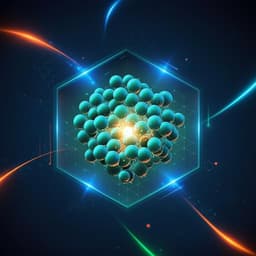
Physics
Intersystem crossing and exciton-defect coupling of spin defects in hexagonal boron nitride
T. J. Smart, K. Li, et al.
Discover groundbreaking insights into the design of quantum defects in wide-bandgap 2D materials, particularly hexagonal boron nitride (h-BN). This research by Tyler J. Smart, Kejun Li, Junqing Xu, and Yuan Ping explores static and dynamic properties, highlighting the potential of single-photon emitters and spin qubits for future technologies.
~3 min • Beginner • English
Introduction
Defect-based spin qubits operable at room temperature offer high-fidelity control but current systems remain inadequate for applications. Two-dimensional materials, particularly hexagonal boron nitride (h-BN), have emerged as hosts for stable single-photon emitters (SPEs) and spin triplet defects, enabling advantages in scalability, spatial doping control, and qubit tuning. Key challenges include the undetermined chemical identity of existing SPEs, difficulties in controlled generation of desired spin defects, and a lack of reliable theoretical methods that capture complex many-body interactions in 2D materials.
A practical strategy is to design extrinsic defects with controllable chemistry. Promising spin qubit candidates should exhibit deep defect levels, stable high-spin ground states, large zero-field splitting (ZFS), efficient radiative recombination, high ISC rates, and long spin coherence/relaxation times. Accurately screening such defects in 2D materials requires methods beyond static mean-field theory: proper charged-defect corrections and electron correlation (e.g., GW or Koopmans-compliant hybrids) to determine charge transition levels; explicit excitonic effects (Bethe–Salpeter equation, BSE) for optical properties due to large exciton binding; advanced treatments for spin-phonon relaxation and nuclear/electron spin coherence; and quantitative evaluation of nonradiative recombination and ISC. While phonon-assisted nonradiative recombination in h-BN defects has been studied, first-principles predictions of SOC-driven ISC in 2D defects have been lacking.
This work develops a comprehensive, first-principles framework incorporating these requirements, including a new approach to compute ISC rates using explicit phonon wavefunction overlap beyond the Huang–Rhys approximation. Applying this framework, we identify TiVV and MoVV as stable triplet defects with sizable ZFS and spin-selective decay in h-BN, and SiV as a bright SPE candidate, positioning engineered 2D defects as competitive platforms for quantum technologies.
Literature Review
Prior studies have demonstrated room-temperature coherent control of defect spin qubits in bulk semiconductors (e.g., diamond, SiC, AlN) and highlighted criteria for viable qubits (deep levels, stable high-spin states, large ZFS, efficient optical cycling, high ISC rates). In 2D materials, h-BN hosts stable SPEs and intrinsic triplet defects (e.g., negatively charged boron vacancy), yet the chemical identity of many emitters remains unresolved. Theoretical advances for 2D defects have addressed accurate defect energetics with charge corrections and electron correlation, and emphasized the necessity of including excitonic effects (BSE) due to strong binding in 2D. Nonradiative recombination mechanisms in h-BN defects have been computed with first-principles electron-phonon coupling, suggesting rates often less competitive than radiative ones. However, spin–orbit mediated ISC—a key pathway for spin-state initialization—had not been treated in-depth from first principles in 2D defects. This work integrates and advances these threads by providing a unified framework and applying it to transition-metal–vacancy complexes and group-IV impurities in h-BN.
Methodology
Screening workflow: Defects at the h-BN divacancy (adjacent VB and VN) were screened for (i) triplet ground state stability via total energy calculations at PBE and hybrid levels; (ii) sizable ZFS; (iii) bright intra-defect optical transitions; and (iv) large ISC rates for spin initialization.
First-principles setup: Structural relaxations and total energies were computed with Quantum ESPRESSO using ONCV pseudopotentials, a 50 Ry plane-wave cutoff, and ≥6×6 supercells with 3×3×1 k-point meshes. Charged-cell energies employed 2D-specific charge corrections implemented in JDFTx. PBE was used for formation energies and geometries; single-point PBEO(α) hybrid (α=0.41 from generalized Koopmans’ condition) was used to mitigate self-interaction for correlated defects.
Many-body perturbation theory: Quasiparticle corrections were computed at G0W0 using YAMBO with PBEO(α) as the starting point. Optical spectra and excitonic effects were obtained by solving the BSE on top of GW. RPA spectra were used only for initial screening; final quantitative properties used GW+BSE.
Defect thermodynamics: Formation energies FE(EF) were computed including chemical potentials for Ti, Mo, and h-BN reservoirs and charge corrections. Charge transition levels were extracted from FE crossings as a function of Fermi level.
Zero-field splitting (ZFS): Spin–spin dipolar contributions were computed in periodic boundary conditions via the Rayson–Briddon plane-wave formalism (post-processing with QE), validated on the NV− center in diamond (D≈3.0 GHz). Spin–orbit contributions to ZFS were computed with ORCA. Axial (D) and rhombic (E) parameters were derived from the ZFS tensor.
Radiative recombination: Radiative rates were obtained from Fermi’s golden rule using excitonic states from BSE. For isolated defect–defect transitions in dilute limit and at low temperature, ΓR ∝ n0 e2 ω3 |μ|2 with ω the transition energy and μ the exciton dipole moment; τR = 1/ΓR. Optical anisotropy and selection rules were captured via exciton wavefunctions.
Phonon-assisted nonradiative recombination: Rates were computed using Fermi’s golden rule within the static-coupling and 1D effective phonon approximations. The rate factors into an electronic overlap term Wif and a phonon overlap χ(T) built from quantum harmonic oscillator wavefunctions along the configuration coordinate. Huang–Rhys factors and Franck–Condon shifts were extracted from configuration coordinate diagrams; Wif was evaluated by finite differences of Kohn–Sham orbitals at Γ. Supercell convergence and validation of the 1D approximation were checked (agreement of S with full-phonon results).
Intersystem crossing (ISC): SOC-mediated ISC between triplet and singlet states was evaluated using a modified phonon-overlap formalism that allows different initial and final vibrational frequencies via explicit phonon wavefunction overlap. The ISC rate ΓISC = 4π η λ χα(T), where λ is the SOC strength and χα(T) the phonon overlap density, was validated by reproducing experimental ISC rates for the NV center. SOC strengths (λ⊥, λ∥) were computed with ORCA via TD-DFT. All rates were evaluated at T = 10 K for comparison with low-temperature experiments.
Key Findings
- Screening identified only TiVV and MoVV (neutral charge state) as stable triplet ground-state defects at h-BN divacancies; both are thermodynamically stable over wide Fermi-level ranges.
- Zero-field splitting (axial D): TiVV ≈ 19.4 GHz; MoVV ≈ 5.5 GHz (including spin–spin and spin–orbit contributions), enabling ODMR without external fields.
- GW+BSE optical properties reveal allowed intra-defect transitions in all three studied defects (TiVV, MoVV, SiV). Transition energies and radiative lifetimes (G0W0+BSE@PBE0(α)):
• TiV: E0 = 0.556 eV; |μ|2 = 2.81×10−2 bohr2; τR ≈ 1.95×10^5 ns (≈195 µs); Eb = 4.018 eV.
• MoV: E0 = 1.079 eV; |μ|2 = 2.29×10−2 bohr2; τR ≈ 3.26×10^4 ns (≈32.6 µs); Eb = 3.965 eV.
• SiV: E0 = 4.036 eV; |μ|2 = 0.628 bohr2; τR ≈ 22.8 ns; Eb = 2.189 eV. Comparable to experimentally observed SPE lifetimes in h-BN; SiV is a strong SPE candidate.
- ZPLs (from BSE vertical excitation minus Franck–Condon shift or from CDFT): TiV ~0.49–0.53 eV; MoV ~0.91–0.92 eV.
- Nonradiative recombination (T = 10 K):
• TiV: Direct triplet–triplet A″→A″ nonradiative lifetime ≈ 8.8×10^2 ps (weak e–ph coupling; S ≈ 0.91). Pseudo-Jahn–Teller (PJT) relaxation in the triplet excited state A″→A′: τ ≈ 394 ps; subsequent A′→A″ decay τ ≈ 0.044 ps (S ≈ 14.95).
• MoV: Direct A′→A″ nonradiative lifetime ≈ 0.02 µs; S ≈ 22.05.
- Spin–orbit coupling strengths (NV validation: λ∥ ≈ 4.0 GHz, λ⊥ ≈ 45 GHz):
• TiV: λ∥ ≈ 149 GHz; λ⊥ ≈ 312 GHz.
• MoV: λ∥ ≈ 16 GHz; λ⊥ ≈ 257 GHz.
- ISC lifetimes (T = 10 K) using explicit phonon-overlap method:
• TiV (A″→A′ singlet): τISC ≈ 83 ps (rate ~12 GHz), providing a fast, spin-selective relaxation pathway.
• MoV (A′→A″ singlet): τISC ≈ 2.7 µs (rate ~0.37 MHz), comparable to NV center ISC rates.
- Overall: Transition-metal defects (TiV, MoV) have long radiative lifetimes (low oscillator strength due to strong exciton localization) and thus low optical quantum yields, but possess viable ISC pathways for spin polarization; SiV shows bright UV emission with ~23 ns radiative lifetime, making it a promising SPE.
Discussion
The framework integrates accurate quasiparticle and excitonic treatments with quantitative radiative and nonradiative dynamics, enabling reliable identification of 2D spin defects. For TiVV and MoVV, sizable ZFS ensures splitting of ms sublevels without external fields, satisfying a key qubit criterion. Their intra-defect transitions are optically allowed but weak (infrared for TiV and near-IR for MoV), yielding long radiative lifetimes and low quantum efficiency. Nonetheless, their strong SOC (especially λ⊥) and computed ISC rates provide spin-selective decay channels analogous to the NV center, enabling optical spin initialization. TiV, in particular, exhibits a dominant fast ISC (≈83 ps), suggesting efficient spin polarization despite low fluorescence. MoV has more favorable ZPL (~1 eV) and improved relative competitiveness between radiative and nonradiative channels, implying more feasible optical control and potential enhancement via cavities or strain. In parallel, SiV shows bright UV emission with radiative lifetime comparable to known h-BN SPEs, supporting its candidacy as a controllable, extrinsic SPE in h-BN. Collectively, these results demonstrate that engineered extrinsic defects can address the chemical identity and reproducibility challenges in 2D emitters and provide viable pathways for spin qubit operation in van der Waals hosts.
Conclusion
This work presents a comprehensive first-principles framework for designing and evaluating spin defects in 2D materials, explicitly incorporating many-body excitonic effects and nonradiative dynamics including spin–orbit mediated ISC with phonon wavefunction overlaps. Applying the workflow to extrinsic defects in h-BN identifies TiVV and MoVV as stable neutral triplet defects with large ZFS and viable, spin-selective ISC pathways, and SiV as a bright SPE candidate with ~23 ns radiative lifetime. The results highlight the importance of exciton–defect coupling in 2D and the necessity of quantitatively treating both radiative and nonradiative processes for realistic device operation. Future work will target first-principles predictions of spin coherence times and dominant decoherence channels, and provide additional spectroscopic fingerprints to facilitate experimental validation, as well as explore device-level strategies (optical cavities, strain) to enhance radiative pathways.
Limitations
- Certain quantities (e.g., ZPLs for triplet–singlet transitions) are difficult to evaluate directly with BSE and were inferred or compared with CDFT approximations.
- Nonradiative rates employ the static-coupling and 1D effective phonon approximations, albeit validated against full-phonon Huang–Rhys factors; multimode effects and anharmonicities are not fully included.
- Calculations are performed at low temperature (10 K) for comparison with cryogenic experiments; full temperature dependence of rates and thermal averaging over excited states were not comprehensively explored.
- Spin coherence and relaxation times were not computed; decoherence mechanisms remain to be quantified.
- Optical properties initially screened at RPA can be unreliable without excitonic effects (final results used GW+BSE). Finite-size and convergence effects were addressed but residual supercell artifacts in 2D systems may persist.
Related Publications
Explore these studies to deepen your understanding of the subject.







